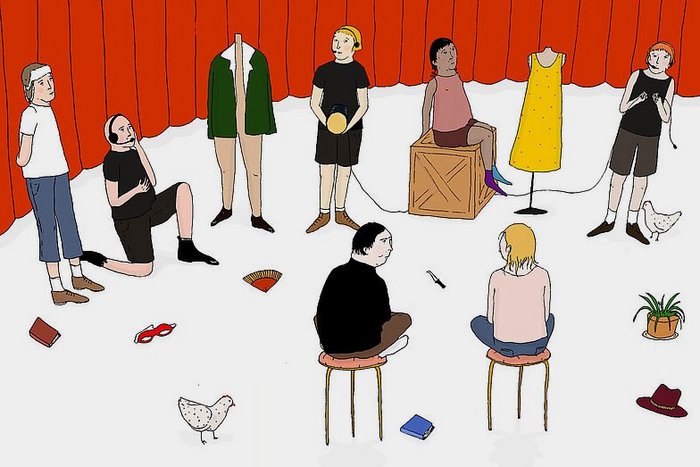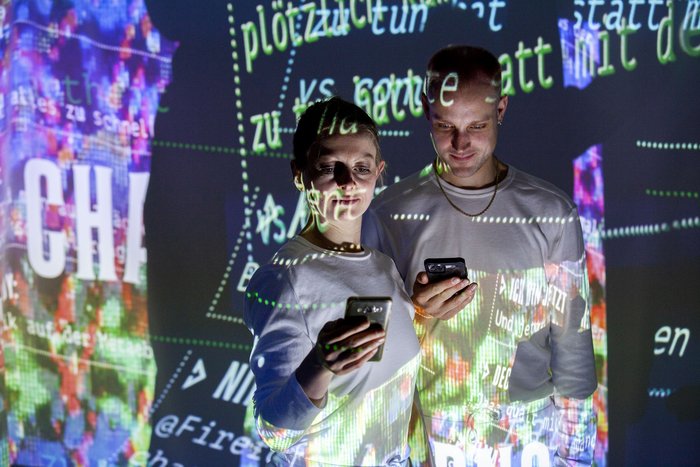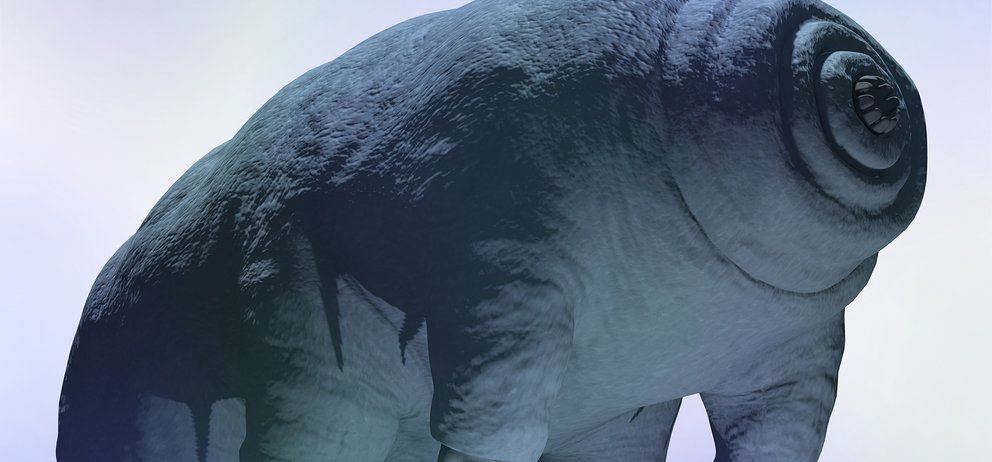Holding the contradictions
An Interview with Nadia Ross and Nina Tecklenburg with Annemie Vanackere
Artists Nadia Ross of the group STO Union and Nina Tecklenburg of the performance collective Interrobang in conversation with Annemie Vanackere about the incisions made by the Corona pandemic, about enduring contradictions and the fruitful connection between theatre and digitality.
Annemie Vanackere: Can you please introduce yourself and the project you'll be presenting at our festival “Spy on Me #4”?
Nadia Ross: The reason we're part of “Spy on Me #4,” well, it’s complicated. We were supposed to be at edition #2 when the pandemic began on March 9, 2020, two and a half years ago. We feel that we are lost in this new world and hanging on to these old threads and beliefs that the performing arts industry is working the way it used to. But in reality, it’s not. So, I’m part of this year’s festival as if this were the past, but it’s not.
Some of us artists were really suffering because of the pandemic. There has been massive inequality. And I’m a white privileged woman, so imagine if you invite someone else who is not in my position, how they would feel. These inequalities in the art industry are profoundly rooted. They are in our canon, they are in our actual texts, they are in our architecture, they’re in everything. The pandemic has revealed this also in the health care as well – it’s been revealed just everywhere.
With that in mind, in our project, I enter the HAU1 building that was built over a hundred years ago, from a pre-internet architecture. It was built with the best of intentions. The architects, designers wanted to open it up to everyone. We look at that building now and see, it’s not accessible. The world has changed. These contradictions that have been everywhere are completely apparent now. I don’t want to lose these contradictions – I want to keep them.
There are so many buildings like that, and that’s what STO Union likes to do: to go into these buildings that are filled with good intentions from another era, and to try to understand them in today's world.
“It was so interesting that all of a sudden, a new community was emerging which in a ‘traditional’ theatre setup is not actually allowed to emerge.” Nina Tecklenburg
NT: I’m part of the company Interrobang. We’ve been making works for eleven years now, and we’ve always been interested in the changes that come with digitality – we're interested in digitality as a topic, and also as a form.
We come from participatory theatre, and digital culture has brought forth so many new ways of participating (just think of the premise of democratisation through digitality), but also of questioning participation (just think of the commodification of participation in the digital realm). So this is something from before the pandemic that we dealt with a lot. We took mechanisms from the digital realm as well as digital communication tools such as voting, polling, feedbacking, liking, chatting, commenting, hypertextual dramaturgy, multi-optionality – we took this and put it into the analogue realm.
Our new project is called “Chat-Inferno”. We started getting interested in the technique of chatting in the context of theatre during the pandemic. It started with live streaming – which I don’t think is a very interesting case of digital theatre – but many live-streaming theatres also offered the chat function. It was so interesting that all of a sudden, a new community was emerging which in a “traditional” theatre setup is not actually allowed to emerge. You know, it felt like Shakespeare’s Globe – people throwing things, or applauding, being very active emotionally.
This question of a community that is remote but also together – that was our basic formal interest for our new piece. Basically, in “Chat-Inferno”, people are walking through a large multimedia installation where they chat with each other via tablets. They wear headsets, and are thus disconnected from each other. The only way they can connect is the chat, and of course the sight, but they are caught up in an audio bubble.
The subtext that we bring to this performance is Dante’s “Inferno”. First we started to think about the digital communication as inferno, that can be both a good thing and a bad thing. Think about online shitstorms, or FOMO – fear of missing out, or Facebook envy and so on. All these new social dynamics cause us stress, but they also enable new forms of social interactions. On the other hand, we are realising the world's four apocalyptic scenarios – of pandemic, of war, of climate crisis, of financial crisis –, the four apocalyptic scenarios from biblical themes, which I find incredible. We are living in an inferno, and, as you said, Nadia, that brings about and intensifies all these inequalities.
“I am offering an artificial intelligence ritual which contains the core of what happens when you go on stage: The hope and the fear.” Nadia Ross
AV: Would you, Nadia, expand also on the aspect of the technology, also with regards to the pandemic situation? You were also interested in technology as a part of a new practice, on how to integrate it.
NR: I’d say, over the last two and a half years, I have done what I always do, which is improvise. I improvise with the environment and with the way things develop. And so the project is an improvisation that responds to the elements at hand. That is sort of the basic premise of my work. I respond to what’s in the room. And over time, I’ve discovered what’s in the room, and what’s in the entire venue. I’ve been able to discover little things about HAU1, and I respond to them.
Theatre is a space that holds contradictions. How do you hold the opposites, the multipolarities of use, and all of these different people’s points of view? How do you hold them in the same moment? Those are binaries and contradictions and polarities that the old wooden stages have always held.
The way I approach it in this piece is that I connect the very ancient art form of theatre with the digital by offering an artificial intelligence ritual, which contains the core of what happens when you go on stage: The hope and the fear, which is the essence of our human digitality.
I see that what I am hoping for and what I am afraid of is at the heart of theatre. It's great for an artificial intelligence programme to take over the questions and ask the public and collect their answers to that. And from that, it creates its final last words: Out of all this input, the AI will choose a sentence that will be its last words before we unplug it, and the actual human-being performance begins. It’s a very interesting experience for AI to have a final statement and die.
NT: I think it’s a very challenging argument to say that theatre is holding the contradictions, because, isn’t it about getting rid of them? But the AI, or the digital technology, is definitely based on zero and one.
However, I find it interesting that when talking about digital theatre, most people tend to become really stressed out, because it might mean the death of theatre. As you said, Nadia, many artists and institutions don't have the privilege to get support. Financially, it has become very difficult, there is less of an audience since the reopening of the theatres.
The question is: Don’t we have to, to a certain extent at least, overcome the idea that there is theatre in this analogue space on the one hand, and there is the digital realm on the other hand? The idea that they are in contradiction with each other, that they are enemies to each other. That’s one of the few good things that came out of the pandemic, that it makes us realise that theatre doesn't exist in this analogue bubble, and that digitality is not this immaterial, unemotional thing. On the contrary: It’s made of those two things simultaneously, it’s made from material and the immaterial. I think digital theatre has the potential not only to reflect on new digitally informed ways of storytelling, but to offer new ways of getting together – it is a new ritual. And it reflects on the digital realm as a new ritual, as a new way of coming together.
I think we, as theatre makers, are experts of social assemblies and of getting people together. And this is what differentiates digital theatre from Netflix: in digital theatres there is a heightened attention, right? There are strategies that theatre people use to make audiences feel this digital liveness, by making audiences visible, making them participate, or by quoting from the “analogue” theatre realm by implementing foyer situations, aftershow talks, etc. The chat function is also a new way of making people aware of digital liveness. There are a bunch of techniques that we use to create this new ritual. And I think this is something that is beyond the binary between the analogue and the digital. It is a hybrid, or whatever we call it – I think we have to invent new terms that overcome, or get rid of this dichotomy.
“There is some kind of mediation among the audience, maybe bringing them even closer through the technology.” Nina Tecklenburg
NR: I agree. It’s not the enemy, and it’s not some mysterious thing either. We’re humans. And we have all these inventions in our heads, so for me it’s not so mysterious, this realm. It’s another tool we've invented. It hasn’t created this mysterious other space. It has created another working space.
But where I give it power, there are people who own this technology and who are taking advantage of us in big ways at every turn. That’s where power is, because that’s where it always goes. We’re not different – human history has not changed. When a powerful tool comes along, the powerful take it for their own benefit, over and over again. It’s not mysterious.
AV: You do not act only in the digital space, the new working space, as you said, Nadia, but your project will take place in a real space at HAU. What can ‘analog’ theatre spaces still offer for you?
NR: When human bodies – physical bodies – sit together in a room, there is a regulation that happens between them. When we experience something together, there's the capacity to deepen neural pathways in a way that almost nothing else does. It’s a kind of medicine. I’m just trying to bring the human body and the person back into this discussion right now, because our bodies have actually gone through a lot in the last two and a half years, and I think it’s really, really important that we acknowledge that. The global situation has affected our brains, our bodies, our spirits, our nerves. We’re shattered.
AV: The way technology is being programmed, or also AI is trained, is so influenced by the interests of the big tech corporations. Nevertheless we at HAU want to look for the positive aspects that technology also can bring. Nina, what is it that digitality can offer to the theatre?
NT: I can understand the need for real bodies to meet in physical spaces, and I think that's what we're doing by putting “Chat-Inferno” into a physical space – however, we add a layer, bringing digitality into a physical space where people are physically present together. There is some kind of mediation among the audience, maybe bringing them even closer through the technology. Of course I could stage something somewhere, a performance with physical touch, that would have a different quality. If we were meeting in a physical space for this conversation, it would be different – however, I wonder if it would be better. I don’t want to pass judgment on this, because [moves closer to the camera] having you as I sit here, 30 centimetres aways from me, is something that would never happen in a face-to-face situation. [Moves away from the camera] I would be at a polite distance. But here [moves close up again], I can create quite some intimacy with you, so there is a new notion of closeness. Also, being able to have a look into your private room, Nadia, offers some sort of intimacy I can’t access when we meet in a third space.
“Accepting different voices is extremely painful. We’ve lost that ability to hold that kind of frustration.” Nadia Ross
NR: I’m getting your point. And I really don’t want to argue about it. I understand that the digital is good, too. It has all these other opportunities. But this is what I’m trying to say: We have to hold these contradictions, we have to find a space to hold these contradictions, and Annemie, you asked me, “How do you do that?” Like, what is that about? Because we have to understand, societies fall apart because of this polarisation, they completely fall apart. Everyone’s too stuck in their opinion, defending their own turf. And accepting different voices is extremely painful. We’ve lost that ability to hold that kind of frustration. We are no longer able to do it. And so, in a sense, that, to me, is the kind of support we need. To help ourselves deal with pain.
NT: In relation to digital technology, I think the one other function of theatre is to enable people coming together, with all these contradictions that it implies: to reflect on the potentials of digital space as a social space, but also to provide a critical distance to the commodification of digital life, to address the fact that it is used by other people to make money, and what an alternative use could be.
AV: This year’s festival subtitle is “New Companions”. My last question is: Do you have new companions? In your life, in your art practice? Who, or what, are they?
NT: In the video I made for the HAU Instagram account, I described this leather leash that I have for my cellphone. Rather than a purely digital companion, it has this materiality, yet it is bound to something digital, and it’s almost turning me into a cyborg. I’m connecting myself. It's a tool that is meant to make my life easier, but at the same time, it creates this interdependency. This cellphone chain or leash has a whole bunch of connotations, it signifies interconnectedness, it brings together the digital and the analogue, the material and the immaterial, it stands for the exploitation of myself as a user, for the potential of helping me through life, for me being depended – addicted? – and surveilled.
AV: Nadia, and you?
NR: My new companion is a crow. I go outside to meet a black crow, who comes and visits, and he takes a few peanuts every day, and he is my new Covid corvid. We met during the pandemic. He's a wonderful bird, and he teaches me so much about nature, and thinking, and performance. Desire is everything. How he reaches the peanut, and how he turns away.
AV: Thank you, and looking forward to you have you with us in HAU!
Interview in cooperation with Sarah Reimann
Part of “Spy on Me #4”:

STO Union
HAU: Out Loud
23.–25.9.2022 / HAU2

Interrobang
Chat-Inferno
30.9.–3.10. / HAU2, HAU4
Image above: NewfrontEars
